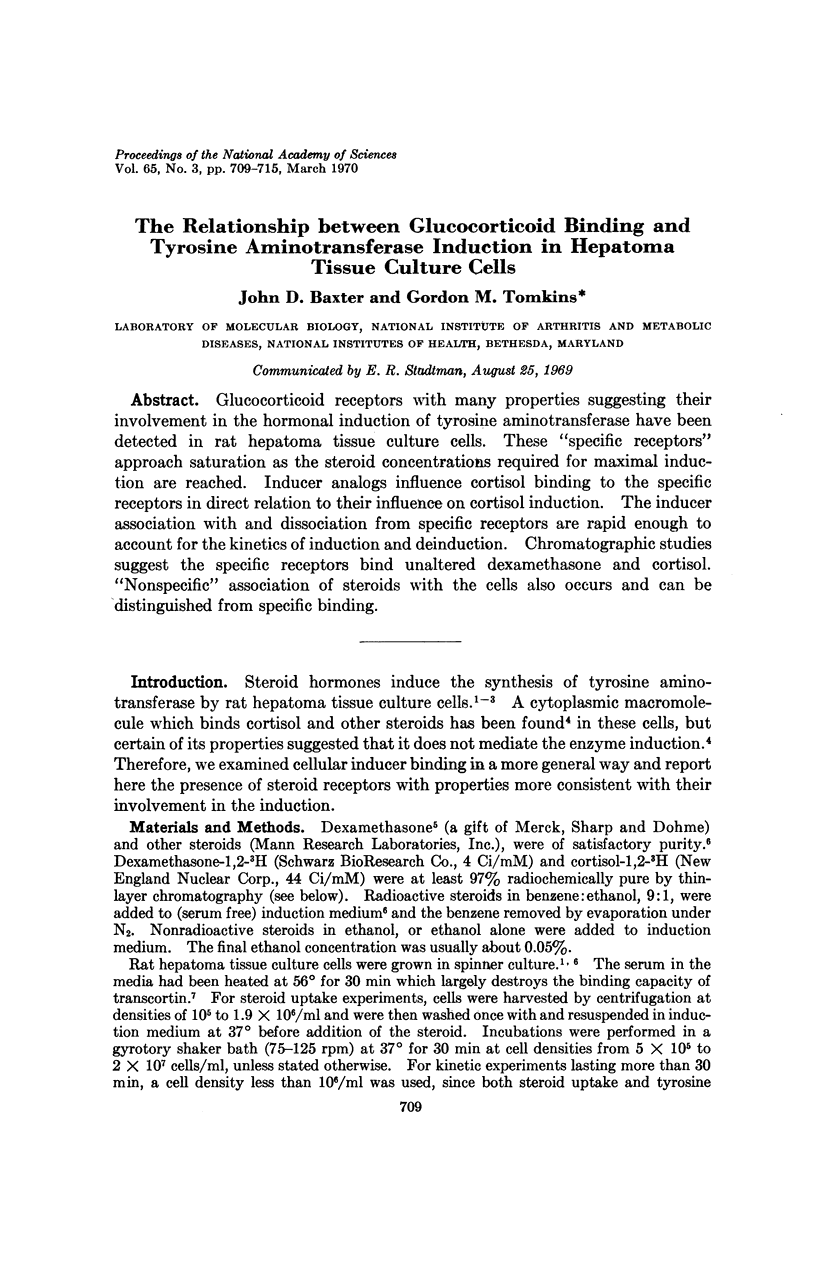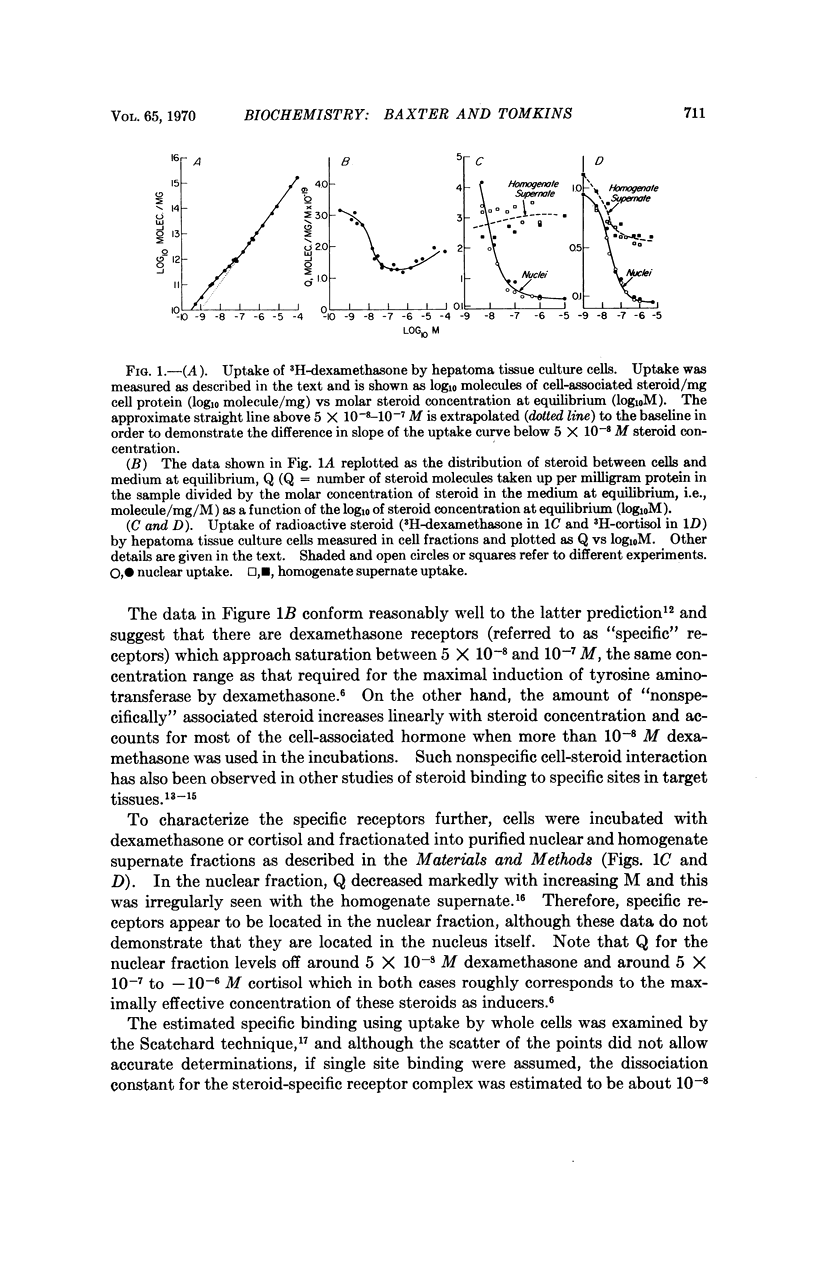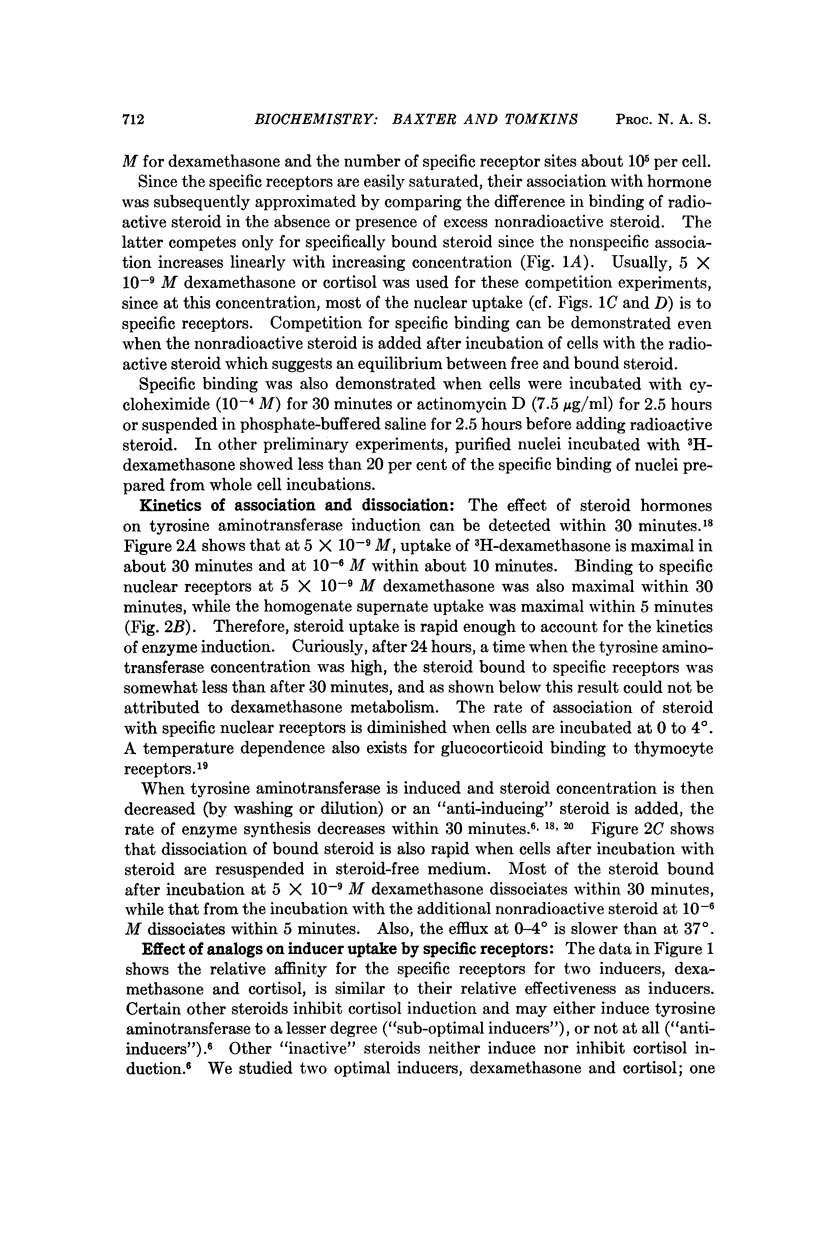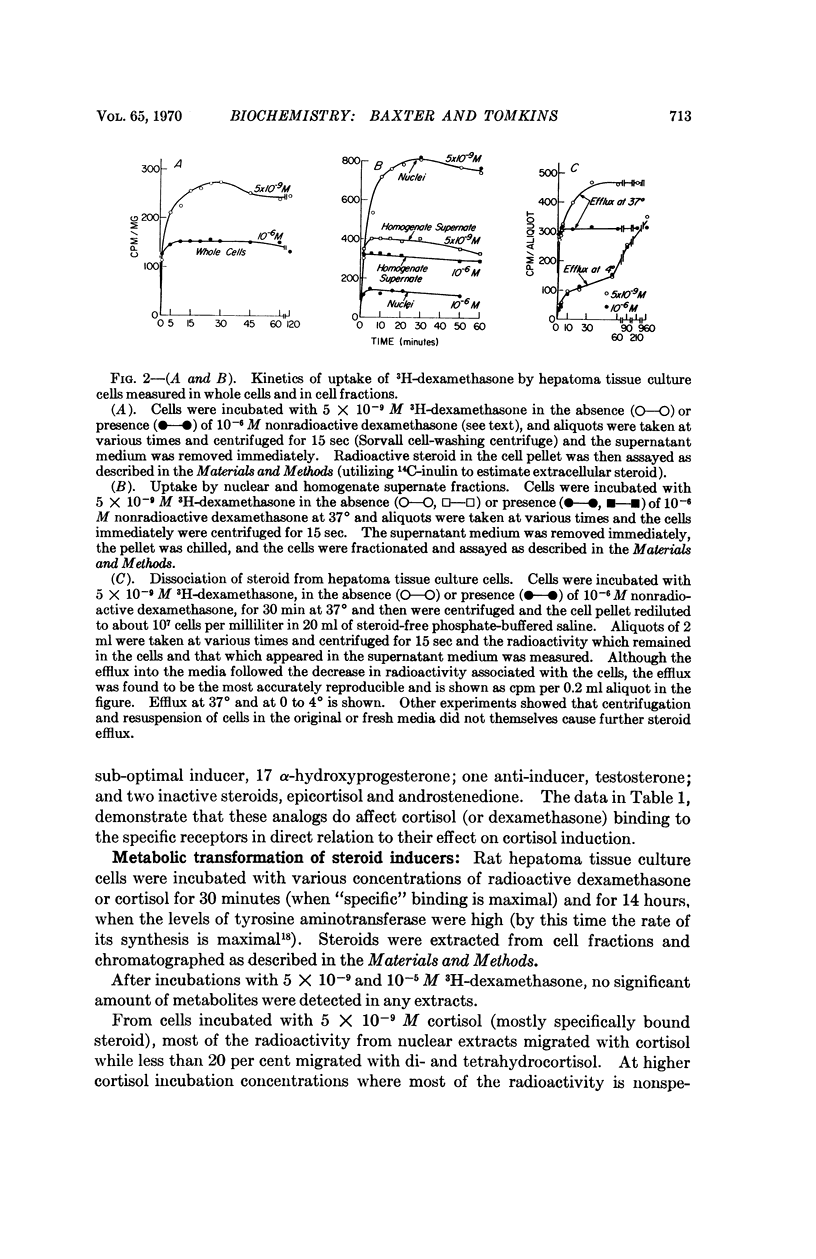Abstract
Glucocorticoid receptors with many properties suggesting their involvement in the hormonal induction of tyrosine aminotransferase have been detected in rat hepatoma tissue culture cells. These „specific receptors” approach saturation as the steroid concentrations required for maximal induction are reached. Inducer analogs influence cortisol binding to the specific receptors in direct relation to their influence on cortisol induction. The inducer association with and dissociation from specific receptors are rapid enough to account for the kinetics of induction and deinduction. Chromatographic studies suggest the specific receptors bind unaltered dexamethasone and cortisol. „Nonspecific” association of steroids with the cells also occurs and can be distinguished from specific binding.
Full text
PDF






Selected References
These references are in PubMed. This may not be the complete list of references from this article.
- Auricchio F., Martin D., Jr, Tompkins G. Control of degradation and synthesis of induced tyrosine aminotransferase studied in hepatoma cells in culture. Nature. 1969 Nov 22;224(5221):806–808. doi: 10.1038/224806b0. [DOI] [PubMed] [Google Scholar]
- Ausiello D. A., Sharp G. W. Localization of physiological receptor sites for aldosteone in the bladder of the toad, Bufo marinus. Endocrinology. 1968 Jun;82(6):1163–1169. doi: 10.1210/endo-82-6-1163. [DOI] [PubMed] [Google Scholar]
- Beato M., Homoki J., Sekeris C. E. On the mechanism of hormone action. XII. Uptake of 1,2-3H-cortisol by isolated rat liver nuclei. Exp Cell Res. 1969 Apr;55(1):107–117. doi: 10.1016/0014-4827(69)90463-7. [DOI] [PubMed] [Google Scholar]
- DULBECCO R., VOGT M. Plaque formation and isolation of pure lines with poliomyelitis viruses. J Exp Med. 1954 Feb;99(2):167–182. doi: 10.1084/jem.99.2.167. [DOI] [PMC free article] [PubMed] [Google Scholar]
- FLORINI J. R., BUYSKE D. A. Plasma protein binding of triamcinolone-H3 and hydrocortisone-4-C14. J Biol Chem. 1961 Jan;236:247–251. [PubMed] [Google Scholar]
- Fanestil D. D., Edelman I. S. Characteristics of the renal nuclear receptors for aldosterone. Proc Natl Acad Sci U S A. 1966 Sep;56(3):872–879. doi: 10.1073/pnas.56.3.872. [DOI] [PMC free article] [PubMed] [Google Scholar]
- Gardner R. S., Tomkins G. M. Steroid hormone binding to a macromolecule from hepatoma tissue culture cells. J Biol Chem. 1969 Sep 10;244(17):4761–4767. [PubMed] [Google Scholar]
- Granner D. K., Hayashi S., Thompson E. B., Tomkins G. M. Stimulation of tyrosine aminotransferase synthesis by dexamethasone phosphate in cell culture. J Mol Biol. 1968 Jul 28;35(2):291–301. doi: 10.1016/s0022-2836(68)80025-7. [DOI] [PubMed] [Google Scholar]
- Herman T. S., Fimognari G. M., Edelman I. S. Studies on renal aldosterone-binding proteins. J Biol Chem. 1968 Jul 25;243(14):3849–3856. [PubMed] [Google Scholar]
- Jensen E. V., Suzuki T., Kawashima T., Stumpf W. E., Jungblut P. W., DeSombre E. R. A two-step mechanism for the interaction of estradiol with rat uterus. Proc Natl Acad Sci U S A. 1968 Feb;59(2):632–638. doi: 10.1073/pnas.59.2.632. [DOI] [PMC free article] [PubMed] [Google Scholar]
- LOWRY O. H., ROSEBROUGH N. J., FARR A. L., RANDALL R. J. Protein measurement with the Folin phenol reagent. J Biol Chem. 1951 Nov;193(1):265–275. [PubMed] [Google Scholar]
- Melnykovych G., Bishop C. F. Relationships between steroid binding and elevation of alkaline phosphatase in HeLa cells. Biochim Biophys Acta. 1969 May 6;177(3):579–585. doi: 10.1016/0304-4165(69)90322-5. [DOI] [PubMed] [Google Scholar]
- Munck A., Brinck-Johnsen T. Specific and nonspecific physicochemical interactions of glucocorticoids and related steroids with rat thymus cells in vitro. J Biol Chem. 1968 Nov 10;243(21):5556–5565. [PubMed] [Google Scholar]
- Schaumburg B. P., Bojesen E. Specificity and thermodynamic properties of the corticosteroid binding to a receptor of rat thymocytes in vitro. Biochim Biophys Acta. 1968 Nov 12;170(1):172–188. doi: 10.1016/0304-4165(68)90171-2. [DOI] [PubMed] [Google Scholar]
- Sharp G. W., Komack C. L., Leaf A. Studies on the binding of aldosterone in the toad bladder. J Clin Invest. 1966 Apr;45(4):450–459. doi: 10.1172/JCI105359. [DOI] [PMC free article] [PubMed] [Google Scholar]
- Sluyser M. Binding of hydrocortisone to rat liver histones. J Mol Biol. 1966 Aug;19(2):591–595. doi: 10.1016/s0022-2836(66)80029-3. [DOI] [PubMed] [Google Scholar]
- Sluyser M. Interaction of steroid hormones with histones in vitro. Biochim Biophys Acta. 1969 May 20;182(1):235–244. doi: 10.1016/0005-2787(69)90538-3. [DOI] [PubMed] [Google Scholar]
- Sunaga K., Koide S. S. Structural specificity of the steroids interacting with calf thymus histones. Biochem Biophys Res Commun. 1967 Feb 8;26(3):342–348. doi: 10.1016/0006-291x(67)90129-5. [DOI] [PubMed] [Google Scholar]
- Thompson E. B., Tomkins G. M., Curran J. F. Induction of tyrosine alpha-ketoglutarate transaminase by steroid hormones in a newly established tissue culture cell line. Proc Natl Acad Sci U S A. 1966 Jul;56(1):296–303. doi: 10.1073/pnas.56.1.296. [DOI] [PMC free article] [PubMed] [Google Scholar]
- Tomkins G. M., Gelehrter T. D., Granner D., Martin D., Jr, Samuels H. H., Thompson E. B. Control of specific gene expression in higher organisms. Expression of mammalian genes may be controlled by repressors acting on the translation of messenger RNA. Science. 1969 Dec 19;166(3912):1474–1480. doi: 10.1126/science.166.3912.1474. [DOI] [PubMed] [Google Scholar]
- Tomkins G. M., Thompson E. B., Hayashi S., Gelehrter T., Granner D., Peterkofsky B. Tyrosine transaminase induction in mammalian cells in tissue culture. Cold Spring Harb Symp Quant Biol. 1966;31:349–360. doi: 10.1101/sqb.1966.031.01.045. [DOI] [PubMed] [Google Scholar]


